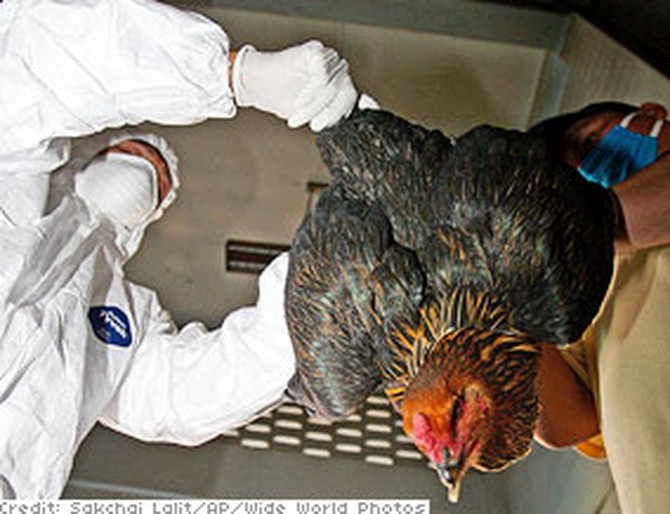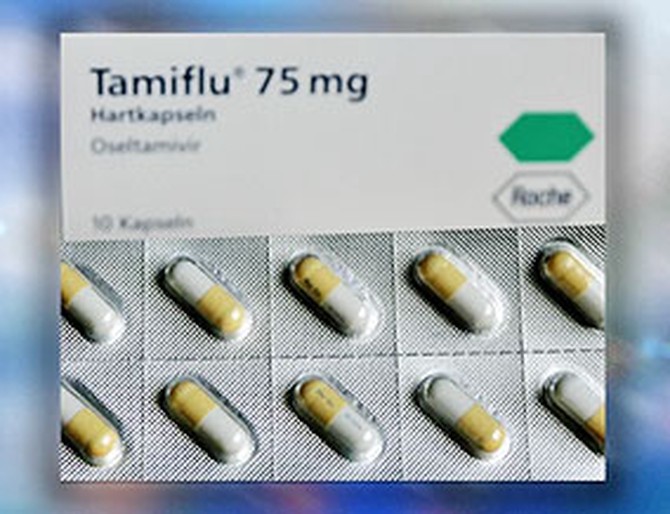The Next Pandemic?

What is bird flu?
Everybody's had the flu at some time in their lives, with its familiar symptoms: aches, chills, fatigue and cough. So why is the "bird flu" making so many headlines?
The deadly virus H5N1 is a strain of influenza normally found only in chickens, turkeys and a variety of other birds. In certain countries, including Vietnam, Indonesia, China, Thailand, Cambodia, Egypt and Turkey, this H5N1 virus has spread to a handful of humans. To date, of the 218 people who have been infected by bird flu, more than half have died. The victims are believed to have contracted bird flu after coming in contact with feces, blood or mucus of infected birds.
At the moment, there is not conclusive evidence that the virus can spread from one human to another. However, this could soon change because the bird flu virus mutates so rapidly. If a mutated strain were able to spread from human to human—an occurrence some medical experts say is inevitable—this highly contagious flu could travel around the globe in a matter of days, infecting every city in every country on the planet.
Everybody's had the flu at some time in their lives, with its familiar symptoms: aches, chills, fatigue and cough. So why is the "bird flu" making so many headlines?
The deadly virus H5N1 is a strain of influenza normally found only in chickens, turkeys and a variety of other birds. In certain countries, including Vietnam, Indonesia, China, Thailand, Cambodia, Egypt and Turkey, this H5N1 virus has spread to a handful of humans. To date, of the 218 people who have been infected by bird flu, more than half have died. The victims are believed to have contracted bird flu after coming in contact with feces, blood or mucus of infected birds.
At the moment, there is not conclusive evidence that the virus can spread from one human to another. However, this could soon change because the bird flu virus mutates so rapidly. If a mutated strain were able to spread from human to human—an occurrence some medical experts say is inevitable—this highly contagious flu could travel around the globe in a matter of days, infecting every city in every country on the planet.

How does bird flu differ from seasonal flu?
According to Dr. Michael Osterholm, an infectious disease expert from the University of Minnesota, understanding the different kinds of influenza viruses can help explain why bird flu is so potentially deadly.
"There really are, in a sense, three different kinds of influenza viruses," he says. "There is that which naturally lives in wild birds. That virus doesn't really hurt us very often."
The second type of influenza, called seasonal flu, is the one most know. Though it is common, this flu virus kills 36,000 people a year, Dr. Osterholm says.
The third kind of influenza virus is the one that has many people extremely worried. It is a flu virus that has mutated from affecting only birds to one that can infect both birds and humans. "That's when we see a pandemic, or a worldwide epidemic," Dr. Osterholm says. "And that's what we worry about."
Why does a flu virus mutate? "When that virus lives inside a bird, it's uniquely made to live inside the cell of a bird," Dr. Osterholm explains. However, "the influenza virus is one of the sloppiest, most indiscreet, most promiscuous viruses we know. It basically doesn't know how to reproduce itself very well, and it makes mistakes all the time. That's called a mutation. Some of those mutations will actually survive, and when they survive, they actually get closer and closer to allowing it to get inside a human cell. Imagine the chicken virus is a key and the chicken cell is the lock. It gets in easily. The human cell is the lock. The chicken key doesn't work well in it. Over time, the mutations change that key just enough so now it readily gets inside a human cell. That's what we're worried about."
According to Dr. Michael Osterholm, an infectious disease expert from the University of Minnesota, understanding the different kinds of influenza viruses can help explain why bird flu is so potentially deadly.
"There really are, in a sense, three different kinds of influenza viruses," he says. "There is that which naturally lives in wild birds. That virus doesn't really hurt us very often."
The second type of influenza, called seasonal flu, is the one most know. Though it is common, this flu virus kills 36,000 people a year, Dr. Osterholm says.
The third kind of influenza virus is the one that has many people extremely worried. It is a flu virus that has mutated from affecting only birds to one that can infect both birds and humans. "That's when we see a pandemic, or a worldwide epidemic," Dr. Osterholm says. "And that's what we worry about."
Why does a flu virus mutate? "When that virus lives inside a bird, it's uniquely made to live inside the cell of a bird," Dr. Osterholm explains. However, "the influenza virus is one of the sloppiest, most indiscreet, most promiscuous viruses we know. It basically doesn't know how to reproduce itself very well, and it makes mistakes all the time. That's called a mutation. Some of those mutations will actually survive, and when they survive, they actually get closer and closer to allowing it to get inside a human cell. Imagine the chicken virus is a key and the chicken cell is the lock. It gets in easily. The human cell is the lock. The chicken key doesn't work well in it. Over time, the mutations change that key just enough so now it readily gets inside a human cell. That's what we're worried about."

Should I really be worried?
Dr. Osterholm says there are a few troubling aspects to bird flu.
Regular flu shots do not work to prevent transmission of bird flu. "Influenza viruses are unique," he says. "We talk about this H5N1, the bird virus. 'H' and 'N' just stand for parts of the virus. Every year, we tell people to get a flu shot because of the mutation problem. This indiscreet, sloppy reproduction changes enough from year to year that we actually need to get a new flu shot every year, unlike other viruses like measles that do not mutate nearly as much."
One year of working to create a bird flu vaccine would only yield enough for about 300 million people—less than 5 percent of the world's population.
Another major concern is the period in which influenza is at its most contagious—a day before symptoms become known. "So right now, if I have an influenza infection, and I'm going to be sick tonight, at midnight when I wake up in the middle of the night with muscle aches, fever and chills, I've already exposed [others to the virus]," Dr. Osterholm tells Oprah. This makes quarantining those infected with the virus incredibly difficult, if not impossible.
To see what a worst-case scenario flu pandemic looks like, Dr. Osterholm points to historical precedent. Though there were other smaller scale pandemics in 1957–58 and 1968–69, the plague of 1918 was clearly the worst. As recounted in historian John M. Berry's The Great Influenza, the 1918 pandemic killed an estimated 50 million people worldwide.
We may not get such a deadly strain of bird flu, but as for completely escaping another pandemic, Dr. Osterholm says, "This is not a probability issue, it's going to happen. What we don't know is which strain it's going to be or when it's going to happen. It could be tonight. It could be 10 years from now. The bottom line is, we have a lot to do to get better prepared."
Dr. Osterholm points to the lack of sufficient drugs, hospital beds and ventilators as key problems if a pandemic were to break out. However, it's not too late to start planning, he says.
Dr. Osterholm says there are a few troubling aspects to bird flu.
Regular flu shots do not work to prevent transmission of bird flu. "Influenza viruses are unique," he says. "We talk about this H5N1, the bird virus. 'H' and 'N' just stand for parts of the virus. Every year, we tell people to get a flu shot because of the mutation problem. This indiscreet, sloppy reproduction changes enough from year to year that we actually need to get a new flu shot every year, unlike other viruses like measles that do not mutate nearly as much."
One year of working to create a bird flu vaccine would only yield enough for about 300 million people—less than 5 percent of the world's population.
Another major concern is the period in which influenza is at its most contagious—a day before symptoms become known. "So right now, if I have an influenza infection, and I'm going to be sick tonight, at midnight when I wake up in the middle of the night with muscle aches, fever and chills, I've already exposed [others to the virus]," Dr. Osterholm tells Oprah. This makes quarantining those infected with the virus incredibly difficult, if not impossible.
To see what a worst-case scenario flu pandemic looks like, Dr. Osterholm points to historical precedent. Though there were other smaller scale pandemics in 1957–58 and 1968–69, the plague of 1918 was clearly the worst. As recounted in historian John M. Berry's The Great Influenza, the 1918 pandemic killed an estimated 50 million people worldwide.
We may not get such a deadly strain of bird flu, but as for completely escaping another pandemic, Dr. Osterholm says, "This is not a probability issue, it's going to happen. What we don't know is which strain it's going to be or when it's going to happen. It could be tonight. It could be 10 years from now. The bottom line is, we have a lot to do to get better prepared."
Dr. Osterholm points to the lack of sufficient drugs, hospital beds and ventilators as key problems if a pandemic were to break out. However, it's not too late to start planning, he says.

Who is most at risk of bird flu?
Dr. Osterholm says a typical flu season kills 36,000 people every year, and the very young and very old are most at risk "because they are the ones that are most vulnerable to infectious diseases."
Not exactly the case with bird flu, he says. If the bird flu is anything like the 1918 pandemic, some of the highest death rates could actually be "those between the ages of 20 and 40."
"In the months of September and October of 1918, 7 percent of the residents of Boston between 20 and 40 years of age died," he says.
How could individuals in the prime of their health be so susceptible to a disease? "It turns out that this virus multiplies very quickly in your body," Dr. Osterholm explains. "The people who have the healthiest immune systems are the ones that succumb to the virus because the immune system goes into overdrive."
The demographic least likely to survive the 1918 pandemic were pregnant women, Dr. Osterholm says. "Fifty-five percent of all pregnant women died from having this flu virus. There is no more precarious time in a healthy person's immune system, than [when they are] pregnant. Part of you says, 'Get rid of that [baby]. It's not all me.' And part of you says, 'This is the most precious cargo I'll ever carry. Protect it.'" This confusion makes bird flu extremely dangerous for pregnant women.
Dr. Osterholm says a typical flu season kills 36,000 people every year, and the very young and very old are most at risk "because they are the ones that are most vulnerable to infectious diseases."
Not exactly the case with bird flu, he says. If the bird flu is anything like the 1918 pandemic, some of the highest death rates could actually be "those between the ages of 20 and 40."
"In the months of September and October of 1918, 7 percent of the residents of Boston between 20 and 40 years of age died," he says.
How could individuals in the prime of their health be so susceptible to a disease? "It turns out that this virus multiplies very quickly in your body," Dr. Osterholm explains. "The people who have the healthiest immune systems are the ones that succumb to the virus because the immune system goes into overdrive."
The demographic least likely to survive the 1918 pandemic were pregnant women, Dr. Osterholm says. "Fifty-five percent of all pregnant women died from having this flu virus. There is no more precarious time in a healthy person's immune system, than [when they are] pregnant. Part of you says, 'Get rid of that [baby]. It's not all me.' And part of you says, 'This is the most precious cargo I'll ever carry. Protect it.'" This confusion makes bird flu extremely dangerous for pregnant women.

Is there a vaccine or prescription drug that can cure the bird flu?
Currently, there is no cure for this virus, Dr. Osterholm says. Scientists and public health officials hope that Tamiflu, a prescription drug designed to fight the common flu, will also help people suffering from the bird flu. Tamiflu has proven very effective against this season's flu strain, but Dr. Osterholm says it doesn't work nearly as well when up against the bird flu.
Before you rush out to your local pharmacy to stock up on Tamiflu, Dr. Osterholm urges people to conserve the nation's supply.
"We don't want to use [Tamiflu] when people don't have the real, serious pandemic flu," he says. "You use it up, and we can't produce it fast enough. So I'm not so sure I want a lot of people going to the pharmacy to buy this, even if they could, because I think we need to strategically place it."
If there's no medication left to offer healthcare workers, Dr. Osterholm says we can't expect them to "walk into the face of fire" and tend to the sick without protection from the disease.
Currently, there is no cure for this virus, Dr. Osterholm says. Scientists and public health officials hope that Tamiflu, a prescription drug designed to fight the common flu, will also help people suffering from the bird flu. Tamiflu has proven very effective against this season's flu strain, but Dr. Osterholm says it doesn't work nearly as well when up against the bird flu.
Before you rush out to your local pharmacy to stock up on Tamiflu, Dr. Osterholm urges people to conserve the nation's supply.
"We don't want to use [Tamiflu] when people don't have the real, serious pandemic flu," he says. "You use it up, and we can't produce it fast enough. So I'm not so sure I want a lot of people going to the pharmacy to buy this, even if they could, because I think we need to strategically place it."
If there's no medication left to offer healthcare workers, Dr. Osterholm says we can't expect them to "walk into the face of fire" and tend to the sick without protection from the disease.

Will wearing a surgical mask protect me from an outbreak?
Dr. Osterholm says certain kinds of masks can clearly reduce your risk of contracting the bird flu. Normal, everyday surgical masks and pieces of cloth tied across your face will do little or nothing to stop the spread of the virus, he says.
Surgical masks prevent doctors from breathing directly on patients, but they have holes and vents on the sides to keep air flowing freely through the mask. Special types of masks (like the N95 Mask Dr. Osterholm is holding above) have sealed sides that can block out contaminated air.
But, even with this kind of mask on, you're still at risk, Dr. Osterholm cautions. The bird flu virus can live outside the mask for two to three days. After one wear, you have to properly dispose of the mask to avoid contact with harmful germs.
There is one more problem with the masks...there won't be enough to go around, Dr. Osterholm says. Pandemics can last for up to two years, and since many of our medical supplies are shipped from overseas sources, Dr. Osterholm predicts that America will run out of masks, prescription drugs and other necessities before the threat is over.
Even Dr. Osterholm won't be safe. "I have to be honest and say I don't have enough masks that would get me through [a pandemic]," he says. "So in a sense, it's as if I almost had a spare tire—but not quite."
Dr. Osterholm says certain kinds of masks can clearly reduce your risk of contracting the bird flu. Normal, everyday surgical masks and pieces of cloth tied across your face will do little or nothing to stop the spread of the virus, he says.
Surgical masks prevent doctors from breathing directly on patients, but they have holes and vents on the sides to keep air flowing freely through the mask. Special types of masks (like the N95 Mask Dr. Osterholm is holding above) have sealed sides that can block out contaminated air.
But, even with this kind of mask on, you're still at risk, Dr. Osterholm cautions. The bird flu virus can live outside the mask for two to three days. After one wear, you have to properly dispose of the mask to avoid contact with harmful germs.
There is one more problem with the masks...there won't be enough to go around, Dr. Osterholm says. Pandemics can last for up to two years, and since many of our medical supplies are shipped from overseas sources, Dr. Osterholm predicts that America will run out of masks, prescription drugs and other necessities before the threat is over.
Even Dr. Osterholm won't be safe. "I have to be honest and say I don't have enough masks that would get me through [a pandemic]," he says. "So in a sense, it's as if I almost had a spare tire—but not quite."

What should I do to prepare for a pandemic?
There are a few simple steps you can take to prepare yourself and your family for a possible pandemic. Dr. Osterholm suggests that you:
There are a few simple steps you can take to prepare yourself and your family for a possible pandemic. Dr. Osterholm suggests that you:
- Stock your cabinets with enough canned goods to last four to five weeks.
- Stockpile your prescription drugs, if possible.
- Speak with city officials to make sure your community has enough chlorine on hand to purify the water, in case shipments stop coming. Many cities only keep enough chlorine on hand to last five to seven days.
There are also many lessons we can learn from the aftermath of Hurricane Katrina, Dr. Osterholm says. Americans need to be prepared to live without modern luxuries, and communities should have a plan to bury their dead in a timely, respectful manner.

How can America prepare for the bird flu?
In December 2005, President Bush requested $7 billion to jump-start a bird flu vaccine program, but Congress only granted $3.1 billion to the cause. Dr. Osterholm thinks Americans need to start holding their congressmen and women, government and healthcare companies accountable.
"There are people in Washington who get it," he tells Oprah. "Now the question is, how do you translate that into action? How do you do that on a worldwide basis?"
Bird flu may not mutate into a disease as serious as the 1918 pandemic, but Dr. Osterholm says the law of probability proves a pandemic will eventually strike again.
"People have to understand that this is not science fiction," he says. "[Pandemics] are going to happen. This is why [a] group of infectious disease [experts] are trying to wake the world up, shake them and say, 'You've got to understand this. Even if the bird flu isn't the one that does it, another one's going to.'"
Like the people of New Orleans learned, this is not the time to panic and feel hopelessness. It's the time to be prepared.
"What we have to do for pandemic flu preparedness is better prepare our world to get the living through it, the sick through it, and then come out the other end as well as we possibly can," Dr. Osterholm says. "That's the difference between being hopeless and hopeful. We're going to come out the other end...it's how well we can come out the other end."
In December 2005, President Bush requested $7 billion to jump-start a bird flu vaccine program, but Congress only granted $3.1 billion to the cause. Dr. Osterholm thinks Americans need to start holding their congressmen and women, government and healthcare companies accountable.
"There are people in Washington who get it," he tells Oprah. "Now the question is, how do you translate that into action? How do you do that on a worldwide basis?"
Bird flu may not mutate into a disease as serious as the 1918 pandemic, but Dr. Osterholm says the law of probability proves a pandemic will eventually strike again.
"People have to understand that this is not science fiction," he says. "[Pandemics] are going to happen. This is why [a] group of infectious disease [experts] are trying to wake the world up, shake them and say, 'You've got to understand this. Even if the bird flu isn't the one that does it, another one's going to.'"
Like the people of New Orleans learned, this is not the time to panic and feel hopelessness. It's the time to be prepared.
"What we have to do for pandemic flu preparedness is better prepare our world to get the living through it, the sick through it, and then come out the other end as well as we possibly can," Dr. Osterholm says. "That's the difference between being hopeless and hopeful. We're going to come out the other end...it's how well we can come out the other end."
Published 01/24/2006

